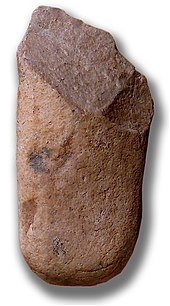Rubble device
Rubble tools ( English : pebble tools ; French galet amenagé ) were the first stone tools made and used by early species of hominini . In the definition of the French archaeologist Louis Capitan (1902), this is massive rubble , mostly river rubble , from which at least one cut was severed by hard impact , so that a sharp working edge was created. The oldest known rubble tools from the Early Stone Age (the African Paleolithic ) are about 2.6 million years old.
Temporal and regional distribution
Rubble devices are u. a. characteristic of the African Oldowan culture , the name of which is derived from artefacts from the Olduvai Gorge . The earliest representatives of the Homo genus are considered to be the producers of the rubble tools : Homo rudolfensis , Homo habilis and Homo ergaster / Homo erectus . More recently, Australopithecines have also been considered as manufacturers of stone tools (cf. Australopithecus garhi ) and thus the time horizon of the oldest rubble tools has been set before the appearance of the genus Homo . Rubble devices, the intentional production of which remains controversial, come from Gona in the Afar triangle (northeast Ethiopia ) with a geologically proven age of around 2.6 million years. Furthermore, rubble tools are known from most of the Early Stone Age sites in Africa, for example from Omo Shungura (Ethiopia), Koobi Fora ( Kenya ), Swartkrans and Sterkfontein ( South Africa ) and Ain Hanech and El-Kherba ( Algeria ).
Rubble devices are not used for Europe; here the oldest settlement horizon begins with the Acheuléen .
From Bolivia and Paraguay isolated surface finds of largely unprocessed river debris from the time before the Conquista are known.
Classification of rubble devices
The American archaeologist Hallam L. Movius, Jr. was different in 1949, the early rubble devices to the technological aspects of the cutting or the way their production: on the one hand, the side beaten chopper , on the other hand, the two sides worked chopping tool . Mary Leakey presented a classification specifically of choppers in the early 1960s on the basis of finds from the Olduvai Gorge (see Chopper (archeology) #Type spectrum ). Another, less widespread classification scheme comes from L. Ramendo from 1963: He differentiates between split, one-sided, two-sided and processed raw materials in several directions.
"Today it is mostly assumed that the razor-sharp chips, separated from the rubble with each stroke, were the primary product of the processing" and were used, for example, for cutting meat, while the kernels were "mainly a by-product in the extraction of chips, although there is no doubt that many cores were also used for powerful blows. "
See also
literature
- Joachim Hahn : Recognizing and determining stone and bone artifacts: Introduction to artifact morphology. Archaeologica Venatoria 10, Tübingen 1991, ISBN 3-921618-31-2 .
Individual evidence
- ↑ Louis Capitan: Un nouveau gisement chelléen, commune de Clérieux, prés Curson (Drome). In: Association française pour l'avancement des sciences. 31ème session. Montauban 1902, pp. 755-757, full text
- Jump up ↑ Lindsay J. McHenry et al .: Compositional and textural correlations between Olduvai Gorge Bed I tephra and volcanic sources in the Ngorongoro Volcanic Highlands, Tanzania. In: Quaternary International. Volume 178, No. 1, 2008, pp. 306-19, doi: 10.1016 / j.quaint.2007.01.004 .
- ↑ S. Semaw, P. Renne, JWK Harris, CS Feibel, RL Bernor, N. Fesseha and K. Mowbray: 2.5-million-year-old stone tools from Gona, Ethiopia. In: Nature . Volume 385, 1997, pp. 333-336 doi: 10.1038 / 385333a0
- ↑ Sileshi Semaw: The World's Oldest Stone Artefacts from Gona, Ethiopia: Their Implications for Understanding Stone Technology and Patterns of Human Evolution Between 2.6-1.5 Million Years Ago. In: Journal of Archaeological Science. Volume 27, 2000, pp. 1197-1214 doi: 10.1006 / jasc.1999.0592
- ↑ M. Baales, O. Jöris, A. Justus and W. Roebroeks: Nature or Culture? On the question of oldest Paleolithic artefact ensembles from main terrace gravel in Germany. In: Germania. Volume 78, No. 1, 2000, pp. 1-20.
- ↑ Lutz Werding: stone tools from Chiquitos. In pre-Columbian times, indigenous people of Bolivia used river rubble as a tool. In: Senckenberg: Nature - Research - Museum. Volume 142, Issue 9/10, 2012, pp. 306-313.
- ^ Hallam L. Movius jr .: The lower paleolithic cultures of Southern and Eastern Asia. In: Transactions of the American Philosophical Society. Volume 38, No. 4, 1948, pp. 329-420, doi: 10.2307 / 1005632 .
- ↑ Joachim Hahn: Recognizing and determining stone and bone artifacts: Introduction to the artifact morphology. Archaeologica Venatoria 10, Tübingen 1991, pp. 140-143.
- ^ Ian Tattersall : The Strange Case of the Rickety Cossack - and Other Cautionary Tales from Human Evolution. Palgrave Macmillan, New York 2015, ISBN 978-1-137-27889-0 , p. 80.

